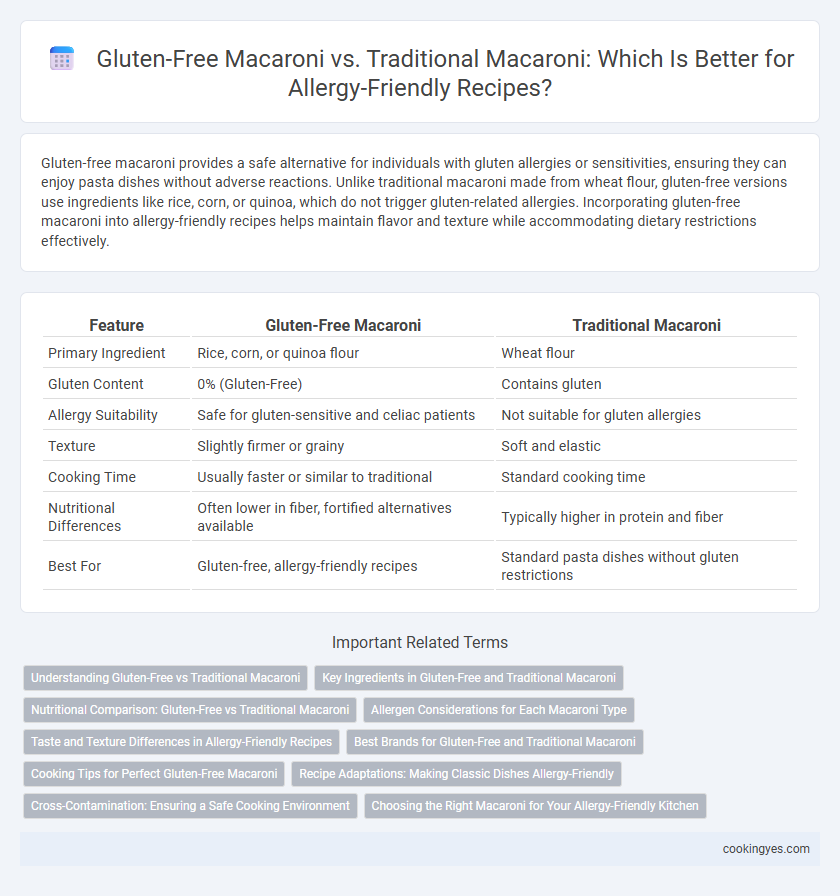Gluten-free macaroni provides a safe alternative for individuals with gluten allergies or sensitivities, ensuring they can enjoy pasta dishes without adverse reactions. Unlike traditional macaroni made from wheat flour, gluten-free versions use ingredients like rice, corn, or quinoa, which do not trigger gluten-related allergies. Incorporating gluten-free macaroni into allergy-friendly recipes helps maintain flavor and texture while accommodating dietary restrictions effectively.
Table of Comparison
| Feature | Gluten-Free Macaroni | Traditional Macaroni |
|---|---|---|
| Primary Ingredient | Rice, corn, or quinoa flour | Wheat flour |
| Gluten Content | 0% (Gluten-Free) | Contains gluten |
| Allergy Suitability | Safe for gluten-sensitive and celiac patients | Not suitable for gluten allergies |
| Texture | Slightly firmer or grainy | Soft and elastic |
| Cooking Time | Usually faster or similar to traditional | Standard cooking time |
| Nutritional Differences | Often lower in fiber, fortified alternatives available | Typically higher in protein and fiber |
| Best For | Gluten-free, allergy-friendly recipes | Standard pasta dishes without gluten restrictions |
Understanding Gluten-Free vs Traditional Macaroni
Gluten-free macaroni is made from alternative flours such as rice, corn, or quinoa, catering to individuals with celiac disease or gluten intolerance, while traditional macaroni typically contains wheat flour, which contains gluten. The texture and cooking time of gluten-free macaroni can differ significantly from traditional varieties, requiring adjustments in recipes to maintain desired consistency and flavor. Allergy-friendly recipes that prioritize gluten-free macaroni ensure safe consumption without compromising on taste for individuals with gluten sensitivities.
Key Ingredients in Gluten-Free and Traditional Macaroni
Gluten-free macaroni is typically made from rice flour, corn flour, or quinoa, which provide a safe alternative for those with gluten intolerance or celiac disease, while traditional macaroni uses durum wheat semolina rich in gluten proteins. The absence of gluten in gluten-free varieties often results in a different texture and cooking behavior compared to the firm and elastic consistency of wheat-based macaroni. Key ingredients like xanthan gum or guar gum are often added to gluten-free macaroni to improve its structural integrity and mimic the bite of traditional pasta in allergy-friendly recipes.
Nutritional Comparison: Gluten-Free vs Traditional Macaroni
Gluten-free macaroni typically replaces wheat with rice, corn, or quinoa flour, offering a lower protein content but similar carbohydrate levels compared to traditional macaroni. Nutritionally, gluten-free options often provide higher fiber and essential minerals like magnesium and iron, catering to those with gluten intolerance or celiac disease. Traditional macaroni remains richer in gluten-based proteins, which contribute to its texture but may trigger allergic reactions in sensitive individuals.
Allergen Considerations for Each Macaroni Type
Gluten-free macaroni, often made from rice, corn, or quinoa, provides a safe alternative for individuals with celiac disease or gluten sensitivity, minimizing the risk of adverse reactions. Traditional macaroni contains wheat gluten, which can trigger allergic responses or digestive issues in sensitive individuals. When selecting macaroni for allergy-friendly recipes, it is crucial to verify labels for potential cross-contamination and ensure that gluten-free products meet certified gluten-free standards.
Taste and Texture Differences in Allergy-Friendly Recipes
Gluten-free macaroni often features a slightly grainier texture and a mild, nutty taste compared to the smooth, chewy consistency of traditional durum wheat macaroni. This difference stems from alternative flours like rice, corn, or quinoa used in gluten-free varieties, which can affect how the pasta absorbs sauces and holds shape during cooking. In allergy-friendly recipes, using gluten-free macaroni enhances accessibility without significantly compromising flavor but may require adjustments in cooking time and sauce pairing to optimize taste and texture.
Best Brands for Gluten-Free and Traditional Macaroni
Gluten-free macaroni brands like Barilla Gluten-Free and Tinkyada offer allergy-friendly options made from rice, corn, or quinoa, ensuring safe consumption for those with gluten intolerance or celiac disease. Traditional macaroni brands such as De Cecco and Ronzoni use durum wheat semolina, providing classic texture and flavor preferred in Italian dishes. Choosing certified gluten-free brands guarantees the absence of cross-contamination, making them ideal for allergy-sensitive recipes without compromising taste or quality.
Cooking Tips for Perfect Gluten-Free Macaroni
Gluten-free macaroni requires precise cooking times to avoid mushiness, typically boiling for 7-9 minutes compared to traditional macaroni's 8-12 minutes, depending on the brand. Rinsing gluten-free pasta under cold water after draining prevents clumping and removes excess starch, enhancing texture and flavor. Using a large pot with ample water and stirring occasionally ensures even cooking and prevents sticking, critical steps for allergy-friendly, gluten-free macaroni recipes.
Recipe Adaptations: Making Classic Dishes Allergy-Friendly
Gluten-free macaroni offers a versatile alternative to traditional wheat-based pasta in allergy-friendly recipes, allowing those with celiac disease or gluten intolerance to enjoy classic dishes without compromising taste or texture. Recipe adaptations often involve substituting traditional macaroni with gluten-free varieties made from rice, corn, or quinoa flour, ensuring the dish remains structurally sound and flavorful. Incorporating gluten-free macaroni requires attention to cooking times and moisture levels to replicate the al dente quality essential for classic macaroni and cheese or pasta salad.
Cross-Contamination: Ensuring a Safe Cooking Environment
Gluten-free macaroni is produced in dedicated facilities to minimize the risk of cross-contamination with wheat-based ingredients, making it a safer choice for individuals with gluten allergies or celiac disease. Traditional macaroni, often made from durum wheat, can pose significant cross-contamination risks if prepared in shared kitchens or with shared utensils. Establishing strict protocols and using separate cooking tools and surfaces are essential to maintain an allergy-friendly environment when handling both types of macaroni.
Choosing the Right Macaroni for Your Allergy-Friendly Kitchen
Gluten-free macaroni made from rice, corn, or quinoa flour offers a safe alternative for individuals with gluten intolerance or celiac disease, maintaining texture and taste close to traditional wheat-based macaroni. Traditional macaroni, while richer in protein and elasticity due to gluten content, poses risks for those with allergies or sensitivities and requires careful ingredient scrutiny. Selecting the right macaroni involves assessing dietary restrictions, ensuring cross-contamination prevention, and choosing brands certified gluten-free to maintain both safety and quality in allergy-friendly recipes.
Gluten-free macaroni vs Traditional macaroni for allergy-friendly recipes Infographic

 cookingyes.com
cookingyes.com